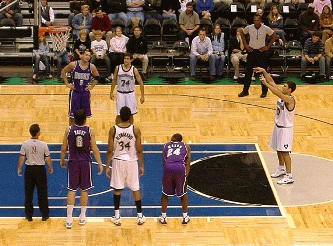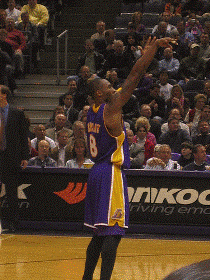How to Improve Free Throw Shooting
- By Don Kelbick
It is almost impossible to overemphasize the importance of free throws, both to teams and to players. If you have a player who can make just 4 baskets per game and add 4 free throws to his total, you have a double-figure scorer. Adding fifteen points from the free throw line to your team's total would create a very difficult obstacle for you opponents to overcome.
In addition, free throw shooting is something that should be consistent and figured into your game plan. Players should incorporate how to get to the foul line into their game.
What is a Good Foul Shooter?
I know this seems like a silly question, but I'll bet your definition is different than ours.
Free throw shooting is a unique skill. It is the only thing that I can think of in all sports that every player should be good at. It is the only skill that the offensive player controls in its entirety. There is no movement to counteract, there is no reaction to the defense, and there is no adjustment for range. Foul shooting is the same skill over and over and over and over again.
Good free throw shooters do the same thing every time. Same shot, same routine, same reactions - make or miss. In the NBA, good free throw shooters are the ones that shoot over 80%. While those are the best of the best players, when you think of it, there really is no reason why players at lower levels can't do the same. Realistically, though, they don't. As you move down in level, the percentages change. On the college level, players who shoot above 75% are considered good shooters; while high school players should shoot over 70%. I, personally, don't think that anyone over 15 years of age (or high school age) who shoots below 70% is a good free throw shooter. I think that, if you shoot below 70%, you should look seriously at making some adjustments, whether it is in form, routine, or thought process.
I say this not as a criticism but as a point to prevent complacency. I think we all understand bad foul shooters, but I think we have to beware, as coaches and players, of players who shoot just well enough to make us believe they are good shooters, but they are not good enough to get you over the hump. It is easy to say you are good enough and massage an ego but you must determine what really is good enough to make you a good player or team. | | 
Picture bySunflowery |
Shooting Foul Shots :
I am not going to into the technical aspects of the foul shot, how to hold the ball, elbow toward the rim, follow through, etc. Those elements are present in all shooting. Free throw shooting is a very personal process and everyone has his own style. However, there should be some common elements, and, since shooting free throws is a repetitive process, each free throw should be the same, shot after shot.
The Court :
In the event that you have not noticed, 99% of inlaid wood basketball courts have a dot right in the middle of the foul line. When installing the court, the baskets and painting the lines, you need to have a reference point upon which you can measure. The installer places a dot on the floor at 15’, directly at the center of the rim. All the lines are laid out from that dot. If you look closely, you will find it.
What is the significance of that dot in regard to free throw shooting?
It’s simple. The dot tells you where to stand. Some players like to stand with their shooting foot on the dot. Some players like to straddle the dot. Some players will stand 3 feet to the side of the dot. I am not going to tell you where to stand. I am only going to say, use the dot so you stand in the same place every time.
Routine :
Fouls shooting routine is one of the places that individuality comes out in regard to foul shooting. Some players will dribble the ball once, some will dribble 3 times. Richard Hamilton likes to take 1 dribble to the side. Jason Kidd likes to wind the ball around his back (he also blows a kiss to his son). The thing that is common amongst those personal expressions is that they do it every time.
What is the purpose of a free throw shooting routine?
It is to help you adjust to the uniqueness of the free throw situation and make it the same shot every time. Think about the changes that take place during a free throw. During the body of the game, you are running, cutting, jumping, adjusting to defense, and reacting to game situations. All of a sudden, you find yourself standing all alone at the free throw line; no one to stop you; plenty of time to get the shot off. It is such a different situation from the rest of the time you are on the court, and the adjustment must be immediate. How do you make the transition from a game player to a free throw shooter? The answer is your free throw shooting routine. Your routine will give you a certain measure of comfort and a trigger mechanism that you need to meet the unique demands of a free throw.
Mental Aspects of Shooting Free Throws :
The great philosopher Yogi Berra once said,"90% of this game is 50% mental." I think that when it comes to free throw shooting, Yogi was underestimating the mental aspects.
We must appreciate how difficult it is to stand at the free throw line, knowing that everyone is watching you, and make a free throw. The flood of thoughts that race through your mind at that time is more like a tsunami. What should you be thinking? The answer is NOTHING!
The purpose of practice is to make your actions automatic; no thought is required. Build in the muscle memory and the psychomotor pathways, and tell your mind to get out of the way. Thinking about your shot will only cause "Analysis-Paralysis." You will study your shot so closely that you will not be able to shoot. Players, at any level, are not immune from this
| | 
Picture byCompujeramey |
I actually had a discussion with a player who has been in the NBA for several years, has multiple championship rings, and is considered one of the best 3-point shooters in the league. However, his free throw shooting percentage hovered around the 50% mark. I asked him how it could be that he is such a good shooter yet has so much difficulty from the line. He proceeded to tell me that when he shoots from the field, he does not have time to think. But when he shoots free throws, he tries to talk himself through his shot. When he misses, he thinks of all the adjustments he has to make. I have seen him make hundreds of free throws in practice. I asked him how many free throws he has taken in his lifetime. He replied that he had probably taken hundreds of thousands over the course of his life as a basketball player. I wondered why that, after so many shots, he thought that after he missed one, he had forgotten how to shoot and had to shoot it differently. It is possible to shoot it correctly and not have it go in. In addition, as a human being, there will be small variations in actions. That does not mean that you have forgotten how to shoot. It is hard enough to master one shot. If you change your shot every time you miss, you will be trying to master several shots. Not a likely scenario for improvement.
So don't analyze your shot after a miss! You're going to miss some shots. Don't worry about it and just shoot the ball!
The other mental aspect that I feel is very important is understanding that all shots are the same and carry their own "intrinsic value," or their own reward and sense of satisfaction. A free throw in the first minute of the game with no score is the same as a free throw in the last second of the game with your team down 1 point. The effects of the shot may be different, but the basket is still in the same place, and so is the free throw line. The shot should be exactly the same in either case. The objective of taking a throw shot is NOT to win or lose a game. The objective is to MAKE THE SHOT! That is the only object. To inject outside values to a particular shot is a recipe for failure.
If you can master these two mental aspects, your effectiveness will improve dramatically!
Practice :
Free throw shooting practice should be just that, practicing your shot. Coaches try to introduce aspects to help shooters shoot in “pressure” situations. I do not believe that works as well as many believe. First, you cannot simulate game situations with game concerns and thought patterns. You can only simulate “game like” situations, which carry different concerns.
Negative ramifications for missed free throw (such as running for misses) does not work either. This only teaches players to be afraid of missing. It does not make them better free throw shooters. If you want to conduct activities for not attaining a goal, make it a positive activity that will improve your players' skills (for example, instead running a sprint for missing a free throw, have your players do a full court, 2 ball dribbling drill).
Shooting when you are tired is also a myth. Repeatable fine motor skills, such as those involved in free throw shooting, depend on building muscle memory through pathways that go from you brain to your shooting motion. Fatigue alters those pathways. It is difficult to improve when making adjustments for fatigue. Rather, you should take enough repetitions when you are fresh so there is no change in your shot when you are tired.
Free throw shooting practice should concentrate on two areas, technical improvement and improving confidence. Repetitive free throw shooting should be a part of a team practice, as should shooting live free throw shots during scrimmage time. However, real improvement as a free throw shooter can only come when a player commits to take the time outside of practice and outside of the season to get his repetitions and work on the mentality of shooting.